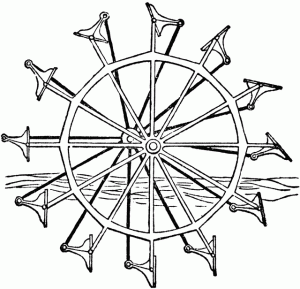Dimensions:
length over all (LOA) 57,88 m
largest width 13,65 m
maximum draft 1,45 m
Propulsion (original):
- a sloping 2-cylinder 500 HP compound steam engine, with a two-fire Scottish fusion pipe boiler.
Propulsion (since 1977):
- Main engine: 620 HP Cummins V12 cylinder diesel, placed in 1976-77 and replaced in 1982 by a new engine of the same type. The power of 620 HP is at a speed of 1800rpm. In practice, the engine runs between 1500 and 1900rpm.
- Hydraulic drive of the paddlewheel with 2 Hägglund hydromotors of 300 hp each.
Originally, the paddlewheels of the Kapitein Kok were driven by a steam engine. During the renovation in 1977, this drive was replaced by equipping each wheel with a hydraulic motor. To compensate for the weight of the heavy steam engine, a thick concrete slab has been poured into the engine room.
With the diesel-hydraulic drive, each wheel can independently rotate forwards or backwards, making it a good way to manoeuvre. If the vanes were to scoop the water in a fixed position, the ship could be slowed down when moving in fast-flowing water due to unnecessary friction in the water. Therefore, the blades are tiltable by connecting the planks (boards) with so-called eccentric rods connected to an axis slightly offset relative to the rad axis (Elijah Galloway patented, in 1829, the Feathered Paddle-wheel). The blades therefore always move in an optimal position in and through the water. The SRodL No. 6 had, similar to most other paddle boats of this shipping company, 8 planks or boards and no outer circle. The wheels of the Kapitein Kok are also rebuilt according to this type.

From the Schuttevaer, August 8, 2009, 121th year, No. 32.
“In 1976 I found the paddle steamer in bad condition in Ludwigshaven“, says Wijnand Key from Rotterdam. “I decided to buy her, to bring her to the Netherlands and renovate. The name became Kapitein Kok, after the last captain. He joined the shipping company (RodL) in 1910 as a deckhand on the river Lek and climbed to the rank of captain at number six. He died, age 91 a few weeks after he had been on board the Kapitein Kok for the last time.
The two-cylinder 500 hp steam engine and the boilers could not be retained (they had already disappeared around 1950 together with the paddle wheels (H.K.)). After much thinking and asking around, I decided to drive the new wheels hydraulically. Steam and hydraulics give a lot of power in low revolutions. A Cummins diesel engine of 620 hp at 1200 rpm drives two large hydraulic pumps. Eccentrics with plunger rotate the axes of the paddle wheels. They can rotate independently of each other and in opposite directions. With 42 revolutions per minute, Kapitein Kok runs sixteen kilometers per hour. One power generator drives the seventy-HP electric bow thruster, a second unit provides the electrics.“
By the way, such a paddle boat of this type could possibly reach 22 km/h in stationary, sufficiently deep water (The No. 6 was slightly slower, so it probably ran 21 km/h). The Kapitein Anna is now deeper in the water, which has increased water displacement and reduced speed a little more.
The 6′ telegraphs were round flat discs, over which the handles could turn around an arc of almost 360 degrees. At the No.5 they were whole round, black discs with white or yellow letters of a kind of stone, on iron bases. However, those of the 6 were the most beautiful; of copper with copper handles, the indication white on black surface and the name of the supplier Spliethoff Beeuwkes & Co. Rotterdam on it. Only the head of these telegraphs was copper, the base was iron, painted brown.
The skirts, which enclosed the lower part of the chimneys and which had slits for ventilation at the top, were painted in yellow.
The cranes with which the walkways were turned out were painted brown. The paddle wheels of No.6 did not contain any outer circles, and had, like the other boats, 8 boards. The steering huts of the Lekboten were always completely closed, both front and rear with left and right a door. The steering wheel was on a copper standard. The main deck of the No.6 ran straight from the prow outwards to the paddle wheel cabinets and then aslant to the stern. All ships had one mobile staircase, in order to be able to move into a rowboat in case of emergency. Hooks were fitted in the deck adge to attach the staircase.
Read more about paddle boats in general.
© Texts based on the sources listed on the Source Listings page

